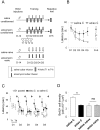Consolidation of an olfactory memory trace in the olfactory bulb is required for learning-induced survival of adult-born neurons and long-term memory
- PMID: 20730099
- PMCID: PMC2921340
- DOI: 10.1371/journal.pone.0012118
Consolidation of an olfactory memory trace in the olfactory bulb is required for learning-induced survival of adult-born neurons and long-term memory
Abstract
Background: It has recently been proposed that adult-born neurons in the olfactory bulb, whose survival is modulated by learning, support long-term olfactory memory. However, the mechanism used to select which adult-born neurons following learning will participate in the long-term retention of olfactory information is unknown. We addressed this question by investigating the effect of bulbar consolidation of olfactory learning on memory and neurogenesis.
Methodology/principal findings: Initially, we used a behavioral ecological approach using adult mice to assess the impact of consolidation on neurogenesis. Using learning paradigms in which consolidation time was varied, we showed that a spaced (across days), but not a massed (within day), learning paradigm increased survival of adult-born neurons and allowed long-term retention of the task. Subsequently, we used a pharmacological approach to block consolidation in the olfactory bulb, consisting in intrabulbar infusion of the protein synthesis inhibitor anisomycin, and found impaired learning and no increase in neurogenesis, while basic olfactory processing and the basal rate of adult-born neuron survival remained unaffected. Taken together these data indicate that survival of adult-born neurons during learning depends on consolidation processes taking place in the olfactory bulb.
Conclusion/significance: We can thus propose a model in which consolidation processes in the olfactory bulb determine both survival of adult-born neurons and long-term olfactory memory. The finding that adult-born neuron survival during olfactory learning is governed by consolidation in the olfactory bulb strongly argues in favor of a role for bulbar adult-born neurons in supporting olfactory memory.
Conflict of interest statement
Figures




Similar articles
-
Learning-dependent neurogenesis in the olfactory bulb determines long-term olfactory memory.FASEB J. 2010 Jul;24(7):2355-63. doi: 10.1096/fj.09-151456. Epub 2010 Mar 9. FASEB J. 2010. PMID: 20215526
-
Newborn neurons in the olfactory bulb selected for long-term survival through olfactory learning are prematurely suppressed when the olfactory memory is erased.J Neurosci. 2011 Oct 19;31(42):14893-8. doi: 10.1523/JNEUROSCI.3677-11.2011. J Neurosci. 2011. PMID: 22016522 Free PMC article.
-
Olfactory learning promotes input-specific synaptic plasticity in adult-born neurons.Proc Natl Acad Sci U S A. 2014 Sep 23;111(38):13984-9. doi: 10.1073/pnas.1404991111. Epub 2014 Sep 4. Proc Natl Acad Sci U S A. 2014. PMID: 25189772 Free PMC article.
-
Newborn neurons in the adult olfactory bulb: unique properties for specific odor behavior.Behav Brain Res. 2012 Feb 14;227(2):480-9. doi: 10.1016/j.bbr.2011.08.001. Epub 2011 Aug 6. Behav Brain Res. 2012. PMID: 21843557 Review.
-
Is adult neurogenesis essential for olfaction?Trends Neurosci. 2011 Jan;34(1):20-30. doi: 10.1016/j.tins.2010.09.006. Epub 2010 Oct 25. Trends Neurosci. 2011. PMID: 20980064 Review.
Cited by
-
Involvement of newborn neurons in olfactory associative learning? The operant or non-operant component of the task makes all the difference.J Neurosci. 2011 Aug 31;31(35):12455-60. doi: 10.1523/JNEUROSCI.2919-11.2011. J Neurosci. 2011. PMID: 21880907 Free PMC article.
-
Context-driven activation of odor representations in the absence of olfactory stimuli in the olfactory bulb and piriform cortex.Front Behav Neurosci. 2014 Apr 29;8:138. doi: 10.3389/fnbeh.2014.00138. eCollection 2014. Front Behav Neurosci. 2014. PMID: 24808838 Free PMC article.
-
Neurogenesis drives stimulus decorrelation in a model of the olfactory bulb.PLoS Comput Biol. 2012;8(3):e1002398. doi: 10.1371/journal.pcbi.1002398. Epub 2012 Mar 15. PLoS Comput Biol. 2012. PMID: 22442645 Free PMC article.
-
A role for dendritic translation of CaMKIIα mRNA in olfactory plasticity.PLoS One. 2012;7(6):e40133. doi: 10.1371/journal.pone.0040133. Epub 2012 Jun 29. PLoS One. 2012. PMID: 22768241 Free PMC article.
-
Dysfunctional Sensory Modalities, Locus Coeruleus, and Basal Forebrain: Early Determinants that Promote Neuropathogenesis of Cognitive and Memory Decline and Alzheimer's Disease.Neurotox Res. 2016 Oct;30(3):295-337. doi: 10.1007/s12640-016-9643-3. Epub 2016 Jun 23. Neurotox Res. 2016. PMID: 27339162 Review.
References
-
- Roullet F, Datiche F, Lienard F, Cattarelli M. Learning-stage dependent Fos expression in the rat brain during acquisition of an olfactory discrimination task. Behav Brain Res. 2005;157:127–137. - PubMed
-
- Martin C, Gervais R, Messaoudi B, Ravel N. Learning-induced oscillatory activities correlated to odour recognition: a network activity. Eur J Neurosci. 2006;23:1801–1810. - PubMed
-
- Mouly AM, Fort A, Ben-Boutayab N, Gervais R. Olfactory learning induces differential long-lasting changes in rat central olfactory pathways. Neuroscience. 2001;102:11–21. - PubMed
Publication types
MeSH terms
LinkOut - more resources
Full Text Sources
Medical

